The Top 10 Cryptozoology Stories of 2008
Posted by: Loren Coleman on December 31st, 2008
The Top 10 Cryptozoology Stories of 2008
by Loren Coleman, Cryptozoologist and Author, Mysterious America, Cryptozoology A to Z, and other books.
From an alleged Bigfoot in ice to a mysterious body on a beach, from a new manta ray to a giant elephant shrew, it was quite a year. It might not have been the year we wanted but it sure was the one we got.

Welcome to this year’s top stories in cryptozoology*, which, in terms of popularity, turned into quite a few months of people talking about strange and unknown animals. Sadly, most of the news items were about hoaxes. (Some stories, like the March tale of the supposed sideway-strolling “Creepy Gnome” of the town of General Guemes, in the province of Salta, Argentina, said to be digitally captured on a cellphone video, was dropped from my list of choices because it hardly seemed cryptozoological and enough hoaxes, already.)
Media was the message this year, nevertheless. Indeed, the Year 2008 will be quite memorable for the wide gap between the news of hoaxes, the few good cryptid sightings, and the remarkable discoveries of the rare new species.
This year’s annual picks were cryptozoological events that became newsworthy or were announced during 2008 (even though, as actual discoveries, they may have happened in an earlier year or years). Muntjacs to mountain gorals walked this way.
The following were the top cryptid-related tidbits of most interest to the public, cryptozoologists, Bigfooters, fans, friends, foes, and the media during the last year. The stories may not be the most groundshaking, but they are the ones that garnered the largest media reaction and greatest public discussions concerning our favorite field of study, for 2008. Enjoy the quest.
This time around, the list below is ranked according to what appeared to be the most “popular” stories to the general media and public, outside of the field of cryptozoology. On a purely raw appeal level, this was a year in which cryptozoology, especially in terms of the top three stories, did have a deep penetration into the global and American popular culture and mass media.
(1) Georgia Bigfoot Hoax.
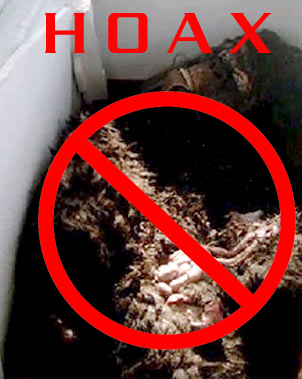
The biggest Bigfoot hoax of the decade started its public journey in July 2008. Clayton County police officer Matt Whitton and alleged former correctional officer Rick Dyer began to tell anyone that would listen that they had tripped over a dead Bigfoot body in the northern Georgia woods in or around June 10th.
They gave a description of the body saying it had a height of eight feet, eight inches, and the fact that, if you were to shave the creature and put a hat on it, you would not be able to distinguish it from a human being. Soon, California promoter Tom Biscardi was involved, and the event took a heightened level in which millions of dollars for the body were discussed.
Despite the fact Cryptomundo readers had identified the costume being used, and others at other sites had too, when a photograph of the complete “body” became available on August 12th, the online and news frenzy continued. Biscardi promised a news conference three days later, and members of the media thought they were going to see the body of a Bigfoot.
The ultimate media circus (dubbed “Bigfoot Friday”) took place on August 15th, when CNN live streamed a news gathering involving 100 news reporters and 38 camera feeds from California. Besides a blobsquatch image of something in the woods and a blurry photo of the tongue of something, no body was shown, no carcass was placed on exhibit, and the media walked away feeling tricked.
But concurrently, the body was being sold to an Indiana construction company owner, who agreed to “loan” Biscardi $50,000 for the body frozen in an ice chest. The “body” was taken to Indiana, unthawed, and by August 19th and 20th, most media outlets had reported that a rubber costume had been discovered under the ice.
Although the media had helped create the Bigfoot frenzy, they would walk away swearing they had been duped by a hoax. Serious Bigfoot researchers had warned this was a hoax early on, but those cautions were forgotten in the wake of this fiasco. The timeline and quotations from this disaster speak for themselves.
How big was this story for 2008 in the mainstream media? Well, it was listed on several year-end lists, from Time to Mad Magazine’s list of “20 Dumbest People, Events, and Things 2008.”
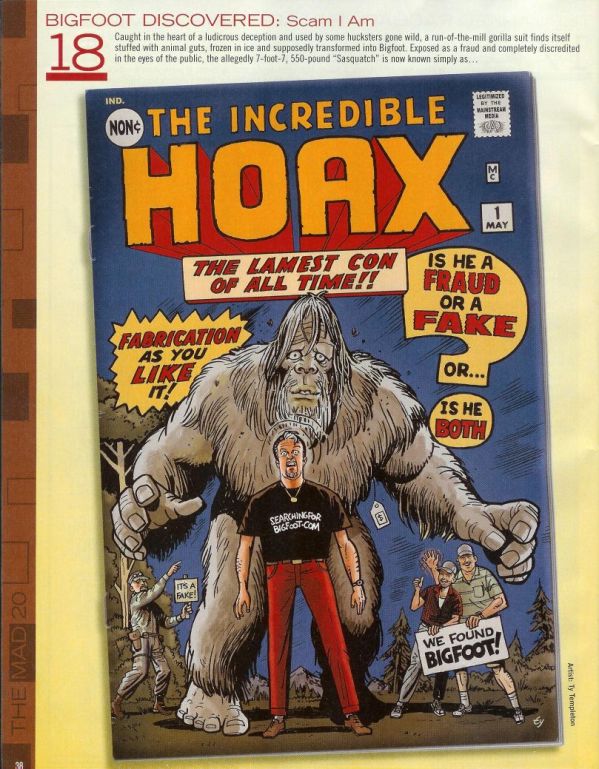
Bigfoot acceptability may have been set back by 25 years.
(2) Montauk Monster.
Something strange washed ashore at Montauk Island, New York, and was photographed on July 12, 2008. It became a media circus for the New York City market. I coined the name “Montauk Monster” for the beached body, and then appeared in an energy drink ad story about it. After lots of back and forth in the blogosphere about what it might be, the consensus appeared to settle on the Montauk Monster being nothing more than a bloated decaying raccoon.
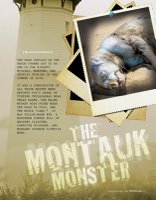
(3) Texas Chupacabras Video.
New footage of a running “Chupacabras” - i.e., in this case, a mystery canid more than any kind of remarkable cryptid - was caught on a dashboard camera by the DeWitt County, Texas, sheriff’s department. This occurred near Cuero, Texas, the new “capital” of Chupacabras activity since an earlier “mystery canid” body was found there.
Below is a silent YouTube version of the police tape, via the local television station KENS 5:
(4) Giant Manta Ray Discovery.
One of the greatest discoveries of cryptozoology for the Year has been the verification of a new species of giant manta ray, the world’s largest species, which was identified for the first time.
During 2008, Marine biologist Dr. Andrea Marshall confirmed that a larger and more elusive manta ray was, in fact, a distinct species. Until then, it was thought that there was only one manta ray species.
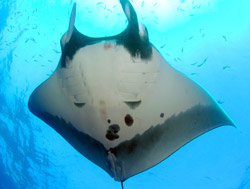
The newly-discovered species (above) leads a different lifestyle than its smaller cousin and is migratory rather than residential. The new giant manta ray has large triangular pectoral fins, which can span almost 26 feet or 8 meters in width and can weigh more than 4409 pounds or 2,000 kilograms.
Dr. Andrea Marshall’s five years of research and finding resulted in her being named 2008’s Cryptozoologist of the Year.
(5) Sumatra Muntjac.
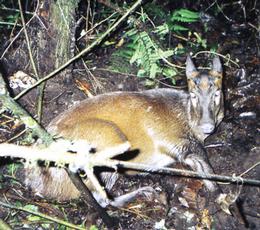
Cryptozoologist Debbie Martyr rediscovered the above photographed Sumatra muntjac (Muntiacus montanus), which was first discovered in 1914, and only last seen in 1930.
Martyr has been in Sumatra for over two decades, as part of a team working for Fauna & Flora International and the Kerinci-Seblat National Park Tiger Protection, which found the muntjac when they rescued it from a hunter’s snare on an anti-poaching patrol 6400 feet above sea level in the national park. Martyr’s primary cryptozoology pursuit has been of the Orang Pendek, and her conservation work has focussed on the area’s nearly extinct tigers.
(6) Colorado Lion.
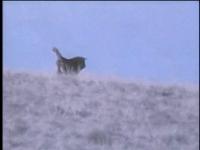
The Associated Press flashed an alert on July 14, 2008, that a large maned felid has been sighted in El Paso County, Colorado, in the Falcon Highway and Log Road area, near Colorado Springs.
“An African Lion has been spotted. Two people reported seeing the lion, including one who captured a photo of the lion chasing dogs,” read bulletin. The “lion” cellphone photograph (above) had been taken by Sharon Harding-Shaw.

A helicopter and members of the El Paso County Sheriff’s Office and Colorado Division of Wildlife were among those searching for the reported African lion in eastern El Paso County. The search for the large cat was called off when it could not be found, and authorities theorized the cryptid was only a dog. But what the solution of this mystery was never fully solved.
(7) Giant Elephant Shrew.
The first elephant-shrew found in 126 years was fully verified.
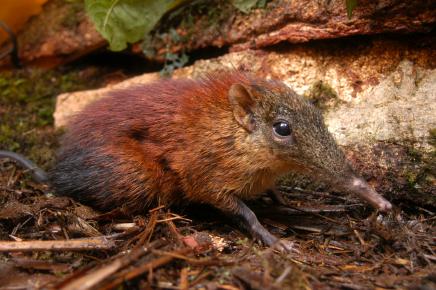
Grey-faced sengi, Rhynchocyon udzungwensis. Photo credit: Francesco Rovero.
Galen Rathbun of the California Academy of Sciences, Francesco Rovero of the Trento Museum of Natural Sciences, and a team of collaborators confirmed the existence of a new species that lives only in two high-altitude forest blocks in the mountains of south-central Tanzania in 2006. But it was not until 2008, when Rathbun’s and Francesco Rovero’s discovery was published in the February 2008 issue of the British-based Journal of Zoology that the discovery was officially announced.
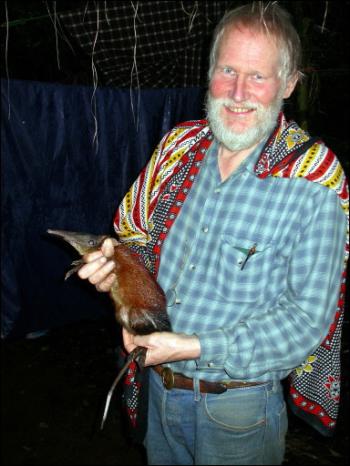
Galen Rathbun with sengi. Photo credit: David Ribble.
Many, many other new species were discovered in 2008.
(8) Yetis.
The Year yielded more than its share of Yeti-related events. As an entire package, in a year when Bigfoot news was often rather negative, the Yeti news was generally positive and celebratory.
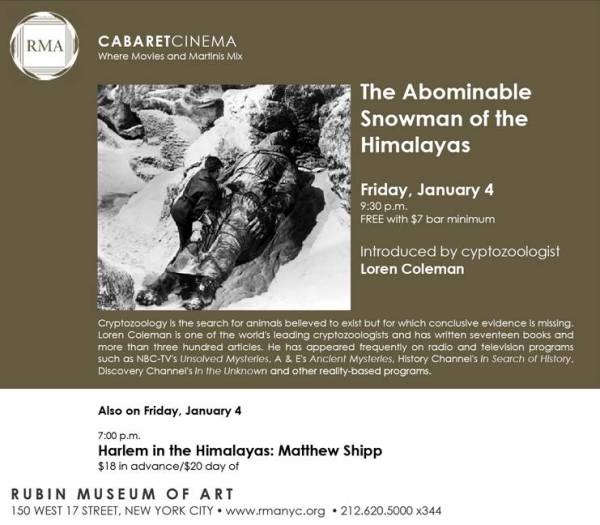
On January 4, 2008, at the Rubin Museum of Art – the museum of Himalayan art in New York City - I was asked to kick off their film festival by introducing the 1957 film The Abominable Snowman of the Himalayas. On the heels of my lecture at the American Museum of Natural History a month before and the other talks I gave in 2008, for example, at the Royal Alberta Museum and the Museum of Science Boston, it signaled a new acceptance of Yetis and cryptozoology in mainstream museums.
The Yeti news came in fast and furious all year.
Ivan T. Sanderson’s classic book, Abominable Snowmen: Legend Come to Life was republished by Cosimo Classics, during the first week in January.
Yeti hunter Sir Edmund Hillary, 88, died January 11, 2008, and most tributes to him noted his ties to the World Book Abominable Snowman expedition of 1960.
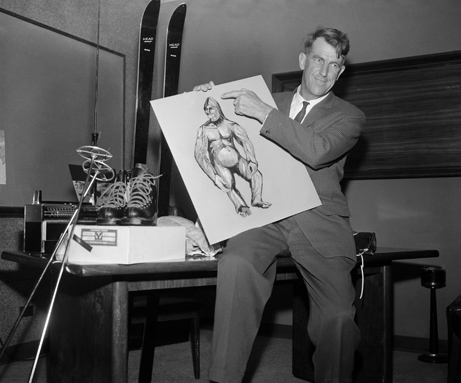
A month after Hillary died, American ornithologist Melvin Alvah Traylor Jr., 92, passed away on February 11th. He was among the members of the 1960 World Book Encyclopedia Scientific Expedition to the Himalaya led by Sir Edmund Hillary.
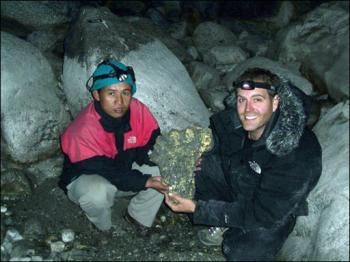
On March 5th, “Destination Truth” opened their second season with an exception to their usual half-hour shows, and broadcast a full hour program on Josh Gates’ finds of Yeti prints in the foothills of the Himalaya.
The third Mummy movie was released, with one of its settings in Tibet involving a sequence on an Army of Yetis.
DNA analysis of Yeti hair gathered in 2003 was revealed in October 2008, to have come from a new population of Himalayan goral (Nemorhaedus goral) in a location in southern Asia formerly unknown.

By fall, AT&T’s Yeti television ad with Bill Curtis was bringing a white Abominable Snowman into living rooms across America.
Later in October, the Japanese Yeti expedition in the Himalayas announced they had found Yeti footprints.
Last, and perhaps least, the Sci Fi Channel premiered on November 8, 2008, a new movie entitled Yeti.
(9) Bigfoot Massacre Theory.

Was the Bigfoot in the famed film from 1967 really shot and killed? Was there a “massacre“? One outspoken individual said he saw some bloody killing fields in the footage and tried to convince others during the spring of 2008 of his “facts.”
If the Georgia hoax story hadn’t come upon the scene a couple months later, people might still be talking about this one.
Bigfoot theorist M. K. Davis got more publicity than he was banking on when he began speculating at Bigfoot conferences that the Patterson-Gimlin film showed “primitive Sasquatch Indians” being massacred.
The full impact of the damage of the Bluff Creek Bigfoot “killing field” theory became apparent when M. K. Davis was asked to not speak at an August Bigfoot meeting and was banned by the hosting Bigfoot museum from attending their conference.
One online critic, the Blogsquatcher wrote an elegantly simple statement that reflected on how people felt about M. K. Davis’ unsupportable “Bigfoot massacre” or “Bluff Creek killing field” theory:
You’ll ultimately have to decide for yourselves how you feel about [M. K. Davis' speculations]. I will leave you with this thought though — for more than 40 years, nothing has been able to diminish the impact of the [Patterson-Gimlin Bigfoot] Film. But maybe this grand conspiracy theory will.Blogsquatcher, May 22, 2008.
Meanwhile, authentic encounters appeared to continue, with 2008’s concentration occurring in British Columbia, especially in June, July, and September-October. One new alleged report on December 28th has surfaced of a Sasquatch being hit be a pickup truck in that same Canadian province.
(10) Scott Norman’s Shocking Death.
As mentioned above, it was a year that saw the mass media talk about the death of Sir Edmund Hillary, frequently mentioning his search for Yeti.
Others died too, of course. The year had the San Francisco Chronicle making a month-long delayed announcement of Bigfoot-bad-boy Erik Beckjord’s demise. Cryptozoologists, Bigfooters, and fellow travelers do die and their lives will to be remembered.

Dave Lowe recalls Forry, who died in 2008.
But it was the sudden death of Mokele-Mbembe hunter Scott T. Norman, at the young age of 43, on the leap day of February 29th, which caught people off-guard.
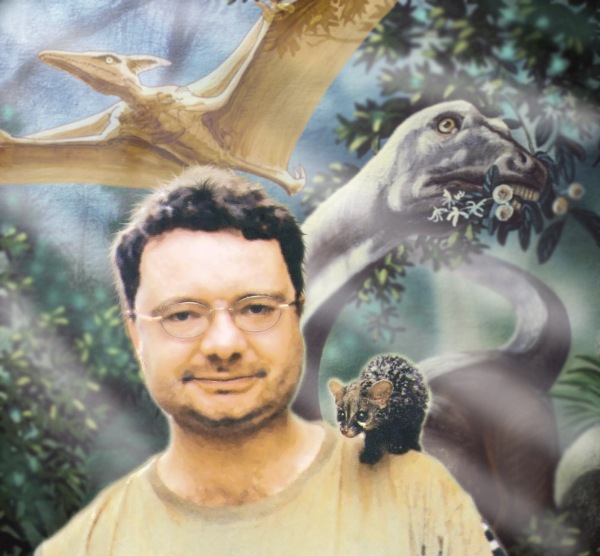
Bill Rebsamen’s tribute art to Scott T. Norman.
Having survived the ridicule of Penn & Teller’s Showtime cable special on cryptozoology, without bitterness and in good spirits, Norman was working on a return to Africa, when he died without warning and somewhat mysteriously.
Others will make the journey to Africa looking for Mokele-Mbembe in 2009, and they will remember Norman and all the others who have gone before, in the continuing search for cryptids and new species.
Here’s hoping for much better things occurring in 2009 - and more good news than bad!
^^^^^^^
*In the 1940s, the Scottish-born American zoologist Ivan T. Sanderson began using a word he coined, “cryptozoology,” to describe a new discipline of science that investigates hidden, yet-to-be-discovered large animals. In the late 1950s, after a decade of correspondence with Sanderson, Belgian zoologist Bernard Heuvelmans began formalizing “cryptozoology,” as a subdiscipline of zoology. Nevertheless, Sanderson was the first to use a form of the word, “cryptozoological,” in print, in 1961.





No hay comentarios:
Publicar un comentario